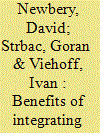|
|
|
Sort Order |
|
|
|
Items / Page
|
|
|
|
|
|
|
| Srl | Item |
| 1 |
ID:
150648


|
|
|
|
|
| Summary/Abstract |
The European Commission's Target Electricity Model (TEM) aims to integrate EU electricity markets. This paper estimates the potential benefit of coupling interconnectors to increase the efficiency of trading day-ahead, intra-day and balancing services across borders. Further gains are possible by eliminating unscheduled flows and avoiding the curtailment of renewables with better market design. In the short run the gains could be as high as €3.9 billion/yr, more than 100% of the current gains from trade. About one-quarter of this total comes from day-ahead coupling and another third from shared balancing. If shared balancing is so valuable, completing the TEM becomes more urgent, and regulators should ensure these gains are paid to interconnectors to make the needed investment in the cross-border links more commercially profitable.
|
|
|
|
|
|
|
|
|
|
|
|
|
|
|
|
| 2 |
ID:
181440


|
|
|
|
|
| Summary/Abstract |
The UK left the EU Integrated Electricity Market on 31/12/20 and with it access to Single Day Ahead Coupling that clears local and cross-border trades jointly – interconnectors are implicitly auctioned. The new Trade and Cooperation Agreement requires a replacement “Multi-region loose volume coupling” to be introduced before April 2022. Until then, interconnector capacity is allocated by an explicit day-ahead auction before the EU auction with nomination after the EU results are known. The article measures the risks posed by taking positions in each market separately and the resulting costs of uncoupling of GB's interconnector trade. It compares four forecasts of price differences under two sequencing of markets and explicit auction, determining traders' risk discounts for each. The current timing leads to lower mistakes on the direction of flows, arguing for retaining current timing. Competitive traders locking in their positions after the explicit auction (overstating costs as subsequent trading out of unprofitable positions is ignored) limit the total loss of interconnector revenue from uncoupling to €31 million/yr. The social cost of uncoupling is €28 million/yr, considerably below earlier estimates in the literature. Experience since uncoupling validates this finding.
|
|
|
|
|
|
|
|
|
|
|
|
|
|
|
|
| 3 |
ID:
096609


|
|
|
| 4 |
ID:
150615


|
|
|
|
|
| Summary/Abstract |
In the energy trilemma of reliability, sustainability and affordability, politicians treat reliability as over-riding. The EU assumes the energy-only Target Electricity Model will deliver reliability but the UK argues that a capacity remuneration mechanism is needed. This paper argues that capacity auctions tend to over-procure capacity, exacerbating the missing money problem they were designed to address. The bias is further exacerbated by failing to address some of the missing market problems also neglected in the debate. It examines the case for, criticisms of, and outcome of the first GB capacity auction and problems of trading between different capacity markets.
|
|
|
|
|
|
|
|
|
|
|
|
|
|
|
|
| 5 |
ID:
181458


|
|
|
|
|
| Summary/Abstract |
Member States have published National Energy and Climate Plans with challenging variable renewable electricity (VRE) targets. As VRE has a high peak to average output, the Single Electricity Market of the island of Ireland (SEM) will need to consider how best to balance the lost value of curtailment against the extra costs of higher Simultaneous Non-Synchronous Penetration (SNSP), more interconnector capacity and/or more storage. The paper develops a spreadsheet model to explore these options for the 2026 VRE targets in the SEM and her neighbours. Raising SNSP from 75 % to 85 % reduces curtailment from 13.3 % to 8.0 %, saving 1338 GWh/yr of spilled wind. Adding the Celtic Link of 700 MW at SNSP of 75 % reduces curtailment to 12.4 % and saves 235 GWh. Adding 100 MW of batteries saves 19 GWh/yr, but the costs of delivering these savings are high. The marginal spilled wind can be four times the average, creating a potentially significant market distortion and reducing the value of adding further VRE.
|
|
|
|
|
|
|
|
|
|
|
|
|
|
|
|
| 6 |
ID:
168652


|
|
|
|
|
| Summary/Abstract |
Interconnectors have value for Britain, providing access to cheaper Continental power, security of supply, and managing increased renewables, prompting proposals for substantial new interconnectors. The EU Target Electricity Model requires interconnector market coupling via Day Ahead and IntraDay Markets. We examine the efficiency and value of uncoupled and coupled trading for the four DC interconnectors to GB, over different timescales from year ahead to intraday, and the social costs and benefits not reflected in the private benefits. Because the GB carbon tax is not replicated abroad it transfers some €65 m./yr to the foreign interconnector part-owners and creates distortions when trade flows change. IFA and BritNed have a commercial value of about €500 million/yr, create additional infra-marginal surplus of €25 m./yr, but suffer €30 m./yr deadweight loss from the asymmetric GB carbon tax. The island of Ireland was coupled in Oct 2018, dramatically reducing trading inefficiency. While further investment in interconnectors appears socially profitable, it is important to harmonise carbon taxes across the EU. If GB leaves the EU and is uncoupled, some of these trading gains would be sacrificed, but other financial markets may alleviate the cost of Brexit, making policies to enhance liquidity desirable.
|
|
|
|
|
|
|
|
|
|
|
|
|
|
|
|
|
|
|
|
|